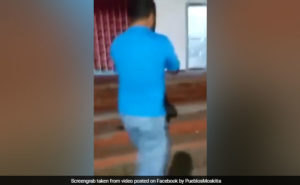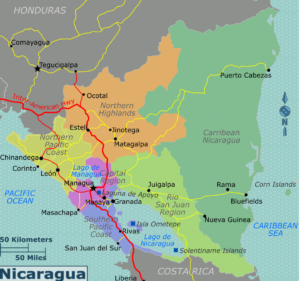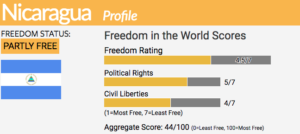Mass demonstrations in Nicaragua turned deadly when police opened fire on protesters, killing at least 25. The protests started on April 18 when the government sought to introduce social security reforms, Foreign Policy reports. President Daniel Ortega remained under pressure on Monday despite backing down on a contentious pension reform plan that triggered four days of violence, AFP adds:
The Central American country’s main private business association — an ally of Ortega during his 11 years in power — said it would go ahead with an anti-government march on Monday. Students who led the protests vowed to keep up their demonstrations until the 72-year-old former Sandinista rebel Ortega and his wife and vice-president Rosario Murillo are ousted.
“We are seeing social chaos in Nicaragua provoked by the absence of government leadership, and the crisis has been combined with poverty — and that in any society is a time bomb,” sociologist and analyst Cirilo Otero told Associated Press.
 Ortega (right) only scrapped the pension cuts after deadly riots, the BBC reports.
Ortega (right) only scrapped the pension cuts after deadly riots, the BBC reports.
“The protests are no longer just for the INSS, it is against a government that denies us freedom of expression, freedom of the press and to demonstrate peacefully,” 26-year-old political science student Clifford Ramirez told AFP. “We believe there is no longer space for dialogue,” he added.
The protests caught most Nicaraguans by surprise as the Ortega administration has delivered economic growth and kept out the drug violence that has plagued Nicaragua’s neighbors. But unease with the authoritarian nature of Mr. Ortega’s presidency had been building for years, and the recent tax increases sparked widespread protests, the Wall Street Journal reports.
“Clearly there is a lot of pent-up frustration,” said Eric Farnsworth, vice president of Washington think tank Americas Society/Council of the Americas. “The government has touted its social peace purchased at the cost of reduced civil liberties and democratic practices.”
 A reporter was shot and killed during a live broadcast, Reuters adds:
A reporter was shot and killed during a live broadcast, Reuters adds:
The man, identified in Nicaraguan media as Angel Gahona (left), was reporting live in the town of Bluefields in the country’s southern Caribbean coast, when a shot rang out and he fell to the ground bleeding in the head, video footage showed.
Desire for change
“The social security law was the trigger but discontent with government policies, including censorship and excessive force in dealing with the protests, is much broader,” said Michael Shifter, the president of the Inter-American Dialogue think tank in Washington. “It won’t be easy for Ortega to regain control of the streets. The chaos of the past few days has revealed a desire for change in Nicaragua,” he told the Wall Street Journal.

Credit: Wikivoyage
The Organization of American States (OAS) urged an immediate end to the violence that has caused these deaths, as well as a significant number of injuries.
“Violent confrontation has never been a political solution, and we urge the opening of spaces for participation that rebuild coexistence between the sides,” it said.
Now in his third consecutive term as president, Mr. Ortega has a strong grip on power, including every branch of government and the military, the New York Times adds.
“The objective of the people on the street, and the dead, was for the presidential couple to leave,” said Fidel Moreira, the executive director of the Center for the Study of Governability and Democracy, which supports the protests. “Looking at logic and how power here is built, that is a little far-off.”
COSEP, a private sector business lobby, said talks could not begin until the government ended police violence, released those arrested for demonstrating peacefully, and re-established freedom of speech, DW adds.
“We urge the government to create these conditions immediately to avoid more bloodshed,” COSEP said. “We cannot go into a dialogue if these minimal conditions are not met.”
 The U.S. State Department accused the government of overreacting to the protests and condemned “the violence and the excessive force used by police and others against civilians who are exercising their constitutional right to freedom of expression and assembly.” The statement called for “broad-based dialogue involving all sectors of society” and urged the authorities to allow an independent investigation into the deaths.
The U.S. State Department accused the government of overreacting to the protests and condemned “the violence and the excessive force used by police and others against civilians who are exercising their constitutional right to freedom of expression and assembly.” The statement called for “broad-based dialogue involving all sectors of society” and urged the authorities to allow an independent investigation into the deaths.
The Ortega regime “has basically shut down a lot of the opposition, a lot of the independent civil society organizations as well as the free media,” said Ambassador Michael Kozak, launching the State Department’s 2017 Country Reports on Human Rights Practices last week.
The Sandinista regime represents a return to caudillismo, Harvard University’s Kai M. Thaler wrote in the National Endowment for Democracy’s Journal of Democracy:
Ortega has followed the path of … other illiberal leaders who have moved from electoral victory to strongman rule. Ortega, however, has resuscitated a variety of authoritarianism—that of the right-wing personalist caudillo—not seen in Latin America for decades, a worrying throwback to darker times. Redemocratization will be a difficult task. Nicaraguans should lead it, but they will need international help.







